Piana degli Albanesi
| Piana degli Albanesi Hora e Arbëreshëvet | ||
|---|---|---|
| Comune | ||
| Comune of Piana degli Albanesi Bashkia e Horës së Arbëreshëvet | ||
|
A view of Piana degli Albanesi | ||
| ||
 Piana degli Albanesi Location of Piana degli Albanesi in Italy | ||
| Coordinates: 37°59′42″N 13°17′00″E / 37.99500°N 13.28333°ECoordinates: 37°59′42″N 13°17′00″E / 37.99500°N 13.28333°E | ||
| Country | Italy | |
| Region | Sicily | |
| Province / Metropolitan city | Palermo (PA) | |
| Government | ||
| • Mayor | Vito Scalia (since May 7, 2012) | |
| Area | ||
| • Total | 64.89 km2 (25.05 sq mi) | |
| Elevation | 740 m (2,430 ft) | |
| Population (2015) | ||
| • Total | 6,429 | |
| • Density | 99/km2 (260/sq mi) | |
| Time zone | CET (UTC+1) | |
| • Summer (DST) | CEST (UTC+2) | |
| Postal code | 90037 | |
| Dialing code | 091 857 | |
| Patron saint | M. St. Hodegetria, St. Demetrius, St. George | |
| Saint day | September 2 October 26, April 23 | |
| Website | Official website | |
| Part of a series on |
| Albanians |
|---|
 |
| States |
| Communities |
| Subgroups |
| People |
Piana degli Albanesi (Albanian: Hora e Arbëreshëvet) is a comune with 6.429 inhabitants in the Province of Palermo, Sicily.
Situated on a mountainous plateau and encircled by high mountains, on the eastern side of the imposing Mount Pizzuta, the city, which is mirrored on a large lake, is 24 km from the provincial capital.
The town is the most important center of the Albanians of Sicily, as well as the largest and most populous colony of Arbëreshë (Italo-Albanian or Albanians of Italy) and it is the episcopal see of the Eparchy of Piana degli Albanesi, constituency of the Italo-Albanian Church whose jurisdiction covers all Albanians of Sicily who practice the Byzantine rite.
The community, after five centuries from its foundation, has maintained many ethnic elements of Albanian culture like language, religious ritual, traditional costumes, music and folklore. The inhabitants are the descendants of Albanian families, including nobles and relatives of Skanderbeg, that settled in Southern Italy during the Ottoman Turkish conquest of the Balkans.
In the modern age it had a significant role in the revolutionary uprisings for the national unification of Italy, for the Albanian National Awakening movement in the struggle for liberation from the Turkish-Ottoman rule and for regional movements of the Fasci Siciliani, furthermore it is also infamous for the Portella della Ginestra massacre (1947). Between 1944 and 1945, which lasted fifty days, Piana degli Albanesi became an Independent People's Republic.
Driven mainly by the romantic principles, Piana degli Albanesi contributed greatly to the advancement of culture and Albanian literature with a large group of intellectuals, decisive process of literary history of Albania. It is considered the place of origin of Arbëreshe literature, the birthplace of the first work of the Albanian diaspora (1592), and initiator – in the early XVII century – of the first European school in which he taught in the Albanian language.
From the town come the university founders of "Albanian Language and Literature" in Naples and Palermo and is headquartered, since 1945, the "Italo-Albanian Seminary", already in Palermo (1734). Its ancient tradition musics and songs Byzantine is part of the ""Registro Eredità Immateriali della Sicilia" (Intangible Heritage Registry of Sicily) recognized by UNESCO. The municipal government uses bilingual documents and road signs in Albanian and Italian under existing Italian legislation on protecting ethnic and linguistic minorities.
History
Piana degli Albanesi was founded in the late fifteenth century by a large group of Albanian refugees coming from the Balkans during the conquest of the latter by the Ottoman Empire.[1][2] The exodus began after the defeat of the Byzantine Empire and the death of Skanderbeg, who successfully fought for the freedom of their people for more than two decades.
The village foundation was officially sanctioned on August 30, 1488, based on an official request sent in 1486–1487 to Cardinal Juan de Borja, archbishop of the Archdiocese of Monreale, demanding the right to remain in the lands of Mercu and Aydingli, located in the mountains in the province of Palermo.[3]
In 1482–85, after several attacks from the Ottoman Empire, the Christian Albanians were forced to the Adriatic coast where they hired ships from Republic of Venice, escaped by sailing and managed to reach the island of Sicily. They apparently were housed in temporary camps somewhere near Palermo until about 1486 or 1487, when they were granted land known initially as the "Plain of the Archbishop", inland areas of Sicily in the mountains above the city of Palermo. Signed the "capitulation" in Albanian and Italian, which were also recognized with followed by the Brief of Pope Sixtus IV,[4] the official concession of land was granted to the settlers in 1488, followed by the construction of what became the largest Albanian center of the island and primarily, religious buildings.
King John II of Spain and Sicily allowed the original refugees to occupy the present place and to preserve their Orthodox Christian rite.[5] These Albanian refugees were at the time referred to by the surrounding population as "Greeks" on account of their Orthodox faith and the settlement became known as Piana dei Greci.[6][7] For example, in 1673, the local priest Domenico Mamola in a note written in Greek refers to the settlement as Piana dei Greci.[5] In 1941 during Mussolini's invasion of Greece, the name was changed to Piana degli Albanesi so as to gain the locals support for the fascist regime's imperialist intentions toward Albania.[7][8] The name Piana degli Albanesi or Plain of the Albanians is a literal translation of the local Arbëreshë name: Hora e Arbëreshëvet.[7]
During the 19th century, the Arbëreshë of Piana degli Albanesi played a significant role for the Italian national unity, and participated in the stronger phases of the movement of Fasci Siciliani.[9] The inhabitants of Piana degli Albanesi were known to have a reputation for rebelliousness, but were not organized politically until the arrival of the Fascio in April 1893.[2]
In 1947, the regional Mafia hired the bandit Salvatore Giuliano to shoot down the annual May Day demonstration of the Pianesi, which took place in a remote mountain pass. The bandit and his gang indeed attacked them there, killing fourteen people in what came to be known as the Portella della Ginestra massacre.
Geography
Location

Piana degli Albanesi is 800 metres (2,600 ft) above sea level in a mountainous valley that ends at the lake of Piana degli Albanesi. It is a mountain resort, whose natural environment and typical mild mediterranean climate create a peaceful and serene oasis. Its natural frame consists of a lake, the mountains and the typical rural quarters.
It is surrounded by four mountains (Pizzuta, Kumeta, Maganoce, Xeravulli), natural sites (Neviere, Cave Garrone, Honi), and the nature reserve Serre della Pizzuta. There are a number of recreational activities available in the area, such as hiking, cycling, horse riding, canoeing, and paragliding.
The territory is crossed by several streams. To the south-east, immersed in the greenness, there is the artificial lake formed in 1923 by damming the Belice Destro river (Lumi Honi), barred in the 1920s to allow for the construction of the Lake of Piana degli Albanesi, since 1999 a natural oasis protected and safeguarded by the World Wildlife Foundation.
Main sights

The historic center of the town has a late-medieval style, reflecting the social status and economic conditions of the time when the settlement was built. The city streets are narrow and consist of steps (shkallët) and neighbourhoods (gjitonia), the roads are generally narrow and provide a meeting place in front of the houses, with the exception of the main road (dhromi i madhë) which is wide and straight and divides the town into different sections. There is also a Piazza Grande (Qaca e Madhe) which is the centre of community relationships.
The churches of the town are among the most important architectural structures, the testimony of these two styles, the baroque linked to the Byzantine Empire and Italian. Of particular interest are the works of the architect and painter Pietro Novelli, very active in the Albanian community.
Religious architecture

The most notable churches in Piana degli Albanesi are:
- The Cathedral of Shën Mitri Dëshmor i Math (St. Demetrius Megalomartyr), which serves as the principal church of the Eparchy of Piana degli Albanesi, the church dates to 1498/1590. The Cathedral is a building dating from the late fifteenth-century, that preserves some significant frescoes by Pietro Novelli. The most ancient work is the icon of the God Mother with the Christ (1500). The presence of two cultures (Byzantine-baroque) is so evident in the place.
- the Church of Shën Mëria e Dhitrjës (St. Mary Odigitria), located in the village main square, was built in 1644 in the style of Pietro Novelli. The church, the only architectural work by Novelli, has the nave divided from the two aisles by four pillars to support the octagonal dome with a small lantern. It preserves a Virgin Odigitria icon that is said to have been brought here by the refugees during their voyage from Albania.
- the Church of Shën Gjergji Dëshmor i Math' (St. George), built in 1492, is the most ancient in the town. It preserves some remarkable frescoes.
- the Church of Shën Kolli (St. Nicholas), an important church which houses precious icons from the seventeenth century.
- the Church of Shën Viti (St. Vito), dating back to 1514, with an imposing portal, which is of Latin rite.
- the Church of Shën Gjoni i Math (Anthony the Great), of the sixteenth century has preserved the altar to the east, typical of Byzantine architecture.
The Monastery of the Basilian Fathers (Sclizza or in Albanian Sklica) of the Byzantine Rite is it in a panoramic spot over the town, you can admire some mosaic works by Spiridione Marino (Dhoni), a local Italo-Albanian artist. From here, it is also worth having a look at the valley below.
Religion
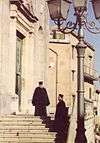
The Comune is the Episcopal see of the Italo-Albanian Catholic Church Eparchy of Piana degli Albanesi for the Arbëreshë of Sicily.[10]
Easter
The town preserves unique Easter traditions, held every year according to a typical itinerary: first of all is the Divine Liturgy, where the Gospel is read in seven languages, including Arabic. After the religious ceremony, there is a procession through the main street, all the women and several men dress in traditional Arbëresh costume, the procession leads to the square after the blessing the red eggs are distributed as a sign of Christ's resurrection.
Culture
Traditional costume
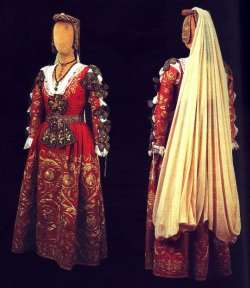
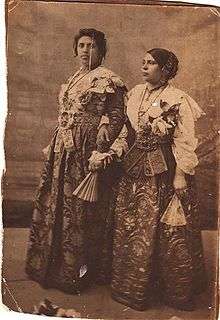

The traditional female costume of Piana degli Albanesi, along with language and the Byzantine rite, is one of the most obvious signs of Arbëreshe cultural identity, and is a unique expression of local self-consciousness, which manifests itself in the desire to retain identity and traditions. From the historical point of view Piana degli Albanesi is one of the most notable Arbëresh communities in Arbëria and Sicily. There are several artistic works on the clothes of Albanians of Piana degli Albanesi, including very valuable Vuillier prints of the eighteenth century, and paintings by Ettore De Maria Bergler, partly preserved at the Art Gallery of the monumental complex of Sant'Anna in Palermo and other private prints, postcards and watercolors by unknown authors. Both the former, together with numerous additional representations portray and demonstrate the incomparability of the costume of Piana degli Albanesi.
The clothes, linked to the various moments of women's lives, from everyday life to marriage, punctuated the rhythms of social tradition of the past. Handed down from mother to daughter, and zealously preserved, they are no longer clothes, but costumes. The progressive loss of this link began in the 1940s, when after the war in Europe there was a need for more practical clothing.
The opulent and elegant clothes have preserved intact their special character, and are worn on special occasions such as baptisms, Epiphany, Easter and especially marriage, continuing to be carefully preserved by the women of Piana degli Albanesi. It costs thousands of euros to make and repair these costumes, and the majority of women use them on these occasions. An epitome of beauty is the bridal costume, which makes it particularly valuable and the religious event of the Byzantine rite. The quality of production is due to the great craftsmanship of the Arbëresh embroiderers in gold and silk wheelwork, velvet and gold (in leads, and lenticciole canatiglie). Embroidery is done using a pillow, a frame or a needle alone.
The traditional female costume of Piana degli Albanesi has been admired through time and consensus. In the competition held in Venice in 1928, in which costume groups from every region of Italy took part, the group from Piana degli Albanesi was awarded first prize, a recognition of their traditional dress as the most sumptuous, rich in design, fabrics and colors out of all the regional competitors.[4]
Language
The most obvious traces of the strong ethnic identity of Piana degli Albanesi is the Albanian language (Arbërisht). It is spoken by all, and can be seen in street names, road signs, and shop signs in the village. The Arbëreshë community has preserved its identity as much as possible. The language shares the widespread language variations seen in southern Albania, mixed at times with Greek phonetics. The language is recognized by the local government and primary schools as a minority ethno-linguistic language. Arbërisht remains the dominant language in the region. Piana degli Albanesi is officially bilingual; the official town documents are written in both Albanian and Italian. The citizens are bilingual, able to use both the Albanian and Italian languages.[11]
The Albanian language is used in radio stations (ex. Radio Hora or Radio Jona), and especially in books and periodicals (ex. Mondo Albanese, Kartularet e Biblos, Albanica, Fluturimi i aikullës, Lajmtari Arbëreshvet or Mirë ditë).
Music
The music and chants of Piana degli Albanesi are deeply tied to religious tradition. The repertoire of sacred songs in Greek and in Albanian language, used throughout the liturgical year of complex and detailed, is very wide. The weekly liturgies, festivals and other officiating are always adorned with a ceaseless flow of melody. The poetic and musical forms are dell'innografia Byzantine liturgical repertory of the museum system is modal theory and follows the Byzantine dell'oktòichos. In addition to these compositions, the prevailing source of educated, there are other evidences of a profane nature, strongly influenced, moreover, of the musical traditions of indigenous origin, it has a large number of popular songs, heritage still very much alive and thriving. The transmission of the songs is, even today, almost entirely through oral tradition. For their documentary value are significant, however, also mentioned the many testimonies pentagram on the manuscript, written, since the beginning of up to 900 times closer to us, priests and monks with the aim of safeguarding the integrity of sacred tradition. The hymns of the Byzantine tradition are performed in celebrations and concerts in the "Corale di San Demetrio" and "Coro dei Papàs di Piana degli Albanesi", while the popular songs from the folk group "Dhëndurët e Arbërit". Among the many heritage, the songs are the most common: Kostantini i vogëlith, Christòs Anèsti, Lazëri, Epi si Chieri, Vajtimet, Simeron Kremate, U të dua mirë, O Zonjë e Parrajsit, Te parkales, Një lule u deja t'isha, Kopile moj kopile, Muaji i mait, Ju lule te këtij sheshi, Trëndafili i Shkëmbit, Lule Borë, Malli çë kam për tij, Përçë ti rron, Perëndesh' e Bukuris, Kur të pash të parën herë, Për Mëmëdhenë, Shkova ka dera jote. The most emblematic songs, one religious and one secular, remain O mburonjë e Shqipëris and O e bukura More.
People from Piana degli Albanesi
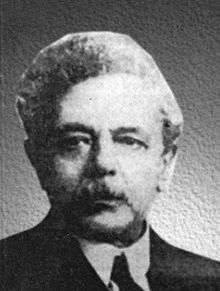
- Luca Matranga (1567–1619), Orthodox priest, writer who gave the official start Albanian literature in diaspora.
- Giorgio Guzzetta (1682–1756), Apostle of the Albanians in Sicily, founder of the "Italo-Albanian Seminary" and priest of Byzantine rite for the sanctity of life and apostolic works memorable.[12]
- Giuseppe Schirò, (1690–1769) Orthodox clergy, writer and archbishop of Durazzo (Albania) of the 18th century.
- Demetrio Camarda (1821–1882), priest of Byzantine rite, Albanian language scholar, historian and philologist.
- Nicola Barbato (1856–1923), doctor and politician among the founders of the movement of the Fasci Siciliani Workers.[13]
- Zef Schirò (1865–1925), poet, historian, linguist, publicist and Albanian patriot, most representative of the Albanian literary and cultural traditions of Sicily.
- Marco La Piana (1883–1958), scholar.
- Ercole Lupinacci (1933), bishop of the Eparchy of Piana degli Albanesi and Lungro of the Italo-Albanian Church.
- Sotir Ferrara (1937), bishop of the Eparchy of Piana degli Albanesi of the Italo-Albanian Church.
- Giuseppe Schirò Di Maggio (1944), poet, journalist, essayist, playwright and writer, among the most influential and prolific exponents of contemporary Arbëreshë literature.
Honorary citizens
- Ismail Kadare (1936), Albanian writer, poet and essayist.
Economy

Agriculture
One of the main local resources is made from tourism, but because of the vast areas devoted to agriculture and its climate, its economy is based primarily on the production of dairy products, cereals, olive oil, wine and fruit, and by herds of sheep, cattle and goats. The office and industrial sector is thriving, the country is precisely known for the presence of accommodation such as guesthouses and restaurants that specialize in preparing dishes of those particular goods
Artistic crafts
A prestigious tradition also belongs to art and craft, including Byzantine style icons created according to the traditional canons. Modern painters of icons (religious pictures on wood) draw inspiration from Byzantine art and spirituality. Even after some centuries, they keep the tradition going in the community of Piana degli Albanesi, and are interpreters of techniques, stylist characters and use of materials, according to every detail established for centuries about this kind of art: the position of the figures, the symbolic gesture, the choice of the colours.
Embroidered with meticulousness elegant women's costumes Arbëreshë in almost continuous production for over five centuries. Other local artists are skilled goldsmiths, especially for production of costume accessories, mosaicists and craftsmen who work with local marble.
Archaeology
Within the confines of Piana degli Albanesi, in Contrada Sant'Agata (Shënt Arhta in Albanian), the remains of an early Christian necropolis of late Roman age, called Pirama, were brought to light in 1988. Evidence of ancient and modern cultural richness of the area, currently subject to archaeological research center.
Video
Gallery
 Bilingual signs in Italian and Albanian
Bilingual signs in Italian and Albanian Roadside shrine showing the words "Falem O Mëri" meaning "Hail Mary" in Albanian
Roadside shrine showing the words "Falem O Mëri" meaning "Hail Mary" in Albanian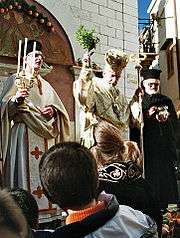 Italo-Albanian Epiphany of the Byzantine rite
Italo-Albanian Epiphany of the Byzantine rite Ancient baroque fountain Tre Kanojvet in the shape of temple (1608)
Ancient baroque fountain Tre Kanojvet in the shape of temple (1608) The ancient main square
The ancient main square The Church of St. George Megalomartyr
The Church of St. George Megalomartyr Italo-Albanian priest (papàs or zoti prift) of Byzantine rite
Italo-Albanian priest (papàs or zoti prift) of Byzantine rite Iconostasi of the Cathedral
Iconostasi of the Cathedral Pietro Novelli (XVII century), the frescoes of the Cathedral
Pietro Novelli (XVII century), the frescoes of the Cathedral Two women in traditional Albanian costume of Piana degli Albanesi
Two women in traditional Albanian costume of Piana degli Albanesi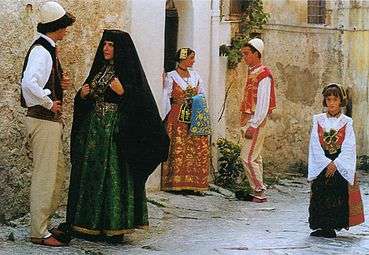 Types Albanian costumes
Types Albanian costumes A typical street of the old town
A typical street of the old town The historical "Bar Shqjpëria" (Bar Albania)
The historical "Bar Shqjpëria" (Bar Albania) Seat of the Municipality (Bashkia)
Seat of the Municipality (Bashkia) Odhise Paskali (1968), Bust of the Albanian Hero Skanderbeg, Garden Comune
Odhise Paskali (1968), Bust of the Albanian Hero Skanderbeg, Garden Comune A traditional Albanian craft store
A traditional Albanian craft store
 Stickers widespread in the Arbëresh city
Stickers widespread in the Arbëresh city
See also
References
- ↑ Widmer, Mary Lou; Landrieu, Moon (September 1, 2006). New Orleans 1900 to 1920. Pelican Publishing. p. 104. ISBN 978-1-58980-401-2. Retrieved October 20, 2010.
- 1 2 Hobsbawm, Eric J. (1971). Primitive rebels; studies in archaic forms of social movement in the 19th and 20th centuries. Manchester University Press ND. p. 101. ISBN 978-0-7190-0493-3. Retrieved October 20, 2010.
- ↑ Petro Scaglione (1921), Lumo Skendo, ed., Historia e Shqipetarevet t'Italise [History of the Albanians of Italy], New York, pp. 38–62, OCLC 40821704
- 1 2 Storia e cultura > Cenni storici della Comunità. www.eparchiapiana.it. Retrieved April 21, 2006.
- 1 2 V Centernario della Stipula dei Capitoli. Patrimonio Librario ed Iconografico, catalogo della mostra. Mezzojuso, 2002. Catalog No. 4, p. 27.
- ↑ Lanaia, Alfio (2008). "Lo schipetaro, il truffatore e il balbuziente: alcuni prestiti albanesi nel siciliano? [The shqiptar, the crook and the stutterer: some Albanian loans in Sicilian?]". Quaderni di semantica. 2. (1): 141. Come sappiamo, gli abitanti dei paesi vicini chiamavano i coloni arbéreshè con l'etnonimo di "greci" o "grecioti" e "Casale dei Greci" era il nome del nucleo urbano da essi abitato, prima che si affermasse l'attuale toponiimo di Biancavilla. Allo stesso modo anche il paese attuale di Piana degli Albanesi, nel palermitano, era chiamato fino al 1941 Piana dei Greci, (a motive del rito religioso) [As we know, the inhabitants of the neighboring areas called the Arbereshe settlers with the ethnonym of "Greek" or "Greeks" and "House of the Greeks" was the name of the urban centre inhabited by them, before they claimed the current toponym Biancavilla. Likewise the present village of Piana degli Albanesi, in Palermo, was called up to 1941 Piana dei Greci, <due to the religious rite>]
- 1 2 3 Fracchia, Joseph (2004). Subaltern Studies and Collective Memories in Piana degli Albanesi: Methodological Reflections on a Historiographical Encounter. Asian Journal of Social Science. 32. (2). 247–248: Piana degli Albanesi or Plain of the Albanians is a literal translation of the village's Albanian name, Hora e Arbëreshëvet. The name provides a quick insight into its history and geography. Piana was founded in 1488 by Albanian refugees fleeing the Turkish conquest of the Balkans and has been inhabited ever since by descendents of the original settlers. The village is situated 24 kilometers south of Palermo on an elevated plain about 740 meters above sea level, and is encircled by rather steep mountains which separate its inhabitants from their Italian neighbours. Not least because of this enclosed geographical site, the Albanians, or Arbëreshë, of Piana degli Albanesi, still retain their language, and religious and cultural traditions. Though most of the several hundred fifteenth-century Albanian settlements in Italy have long since been assimilated, Piana remains "the most self- consciously Italo-Albanian" village and is considered "the spiritual center of the Albanians of Sicily (Hobsbawm, 1965:102; Serra, 1987:12). The other striking historical fact is the long tradition of Pianese revolutionary commitment which led the British historian Trevalyn to call Piana "the hearth of freedom in Western Sicily" (1909:158), and which attracted Hobsbawm's attention. The early struggles were of the Pianese against outsiders: feudal overlords, followed by monarchs. Since the 1890s, however, bitter social conflicts within the village that pit Pianese peasants against the local landholding elite gave rise to a remarkable degree of revolutionary activity, with some two-thirds of the adult population enrolled first in the socialist and then, after 1919, in the communist party."; p. 269. "Rossi, and Hobsbawm and Guha following him, refer to the town as Piana dei Greci — a name it received from the Italians because of the Albanians’ Greek Orthodox Christianity. Ironically, Mussolini, presumably in an attempt to gather support for his imperialist intentions toward Albania, changed the name to Piana degli Albanesi."
- ↑ Di Marco P., Musco A. Aspetti della cultura bizantina ed albanese in Sicilia, Officina di Studi Medievali, 2005 p. 85
- ↑ The Albanians: An Ethnic History from Prehistoric Times to the Present, Edwin E. Jacques, 1994.
- ↑ "Diocese of Piana degli Abanesi". GCatholic.org. Retrieved December 27, 2011.
- ↑ New Albanian Immigrants in the Old Albanian Diaspora: Piana Degli Albanesi. Eda Derhemi
- ↑ "Cenni biografici". www.oratoriosanfilippo.org/index.html. Retrieved September 10, 1998. Check date values in:
|access-date=(help) - ↑ (Italian) DE PLANAE ALBANENSIUM VIRIS ILLUSTRIBUS: Personaggi illustri, Comune di Piana degli Albanesi (Accessed October 31, 2010)
Notes
External links
| Wikimedia Commons has media related to Piana degli Albanesi. |
- Jemi – Il portale degli Arbëreshë (Italian)
- Official site of Piana degli Albanesi (Italian)
- Liturgical portal of the Eparchy of Piana degli Albanesi (Italian)
- Mirë ditë – Information magazine of cultural at Piana degli Albanesi (Italian)




